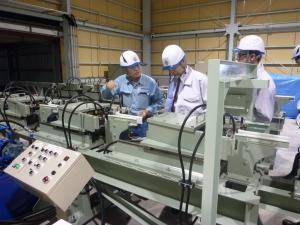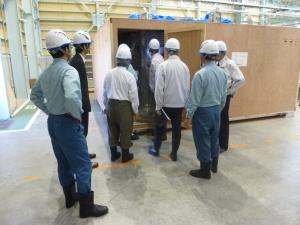Japan leads superconductor manufacturing for ITER
11 Jun 2010
-
Arnaud Devred, Superconductor Section Leader
G. Johnson and A. Devred listening to an explanation by a Nippon Steel Engineering officer about cable insertion, a critical step of conductor manufacturing.
Japan was the first Domestic Agency to sign a Procurement Arrangement with the ITER Organization. The Procurement Arrangement for the conductor for the toroidal field magnets was signed in November 2007, and since then Japan has been at the forefront of toroidal field conductor production. As of today, the two Japanese firms Jastec and Hitachi Cable have produced more than 50 tonnes of niobium-tin (Nb3Sn) superconducting strands.
Hitachi Cable has cabled more than 3.8 kilometres of toroidal field cables. In addition to several qualification unit lengths, Nippon Steel Engineering has completed the manufacture of 4 x 430-metre conductor unit lengths that will be used for the winding of side double pancakes. It is getting ready to jacket its first 780-metre conductor unit length that will be used for the winding of a regular double pancake. The four-side double pancake unit lengths are the first ITER Tokamak components to be completed.
The ITER delegation inspects a wooden crate containing a completed toroidal field conductor unit length ready to be shipped by Nippon Steel Engineering for storage in a nearby warehouse.
From June 8-11, Gary Johnson, Head of the Tokamak Department, led a delegation of ITER Organization experts visiting the Japanese Atomic Energy Agency (JAEA) and the various suppliers involved in toroidal field conductor production. "It is very important at this stage of the project to acknowledge and support the efforts of the Domestic Agencies in stepping up their industrial contracts, and it is a significant milestone to see the completion of the first tokamak components. This sends a strong signal to the world that ITER has entered the construction phase and should encourage all the Domestic Agencies to pursue their efforts," said Gary during his visit.
The strands, cables and conductor unit lengths have undergone or are now undergoing acceptance testing at the various suppliers, as well as verification testing at JAEA as required by the Procurement Arrangement. All data are entered into the Conductor Database for validation and checking. The Japanese suppliers have set very high standards in terms of quality and uniformity of production that will be used as a reference for production around the world. Of course, there has been a learning phase, but initial problems were quickly overcome thanks to a tight collaboration between the ITER Organization and JAEA.



